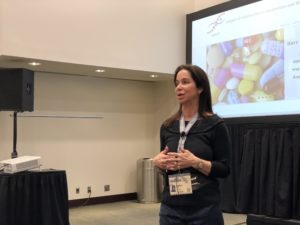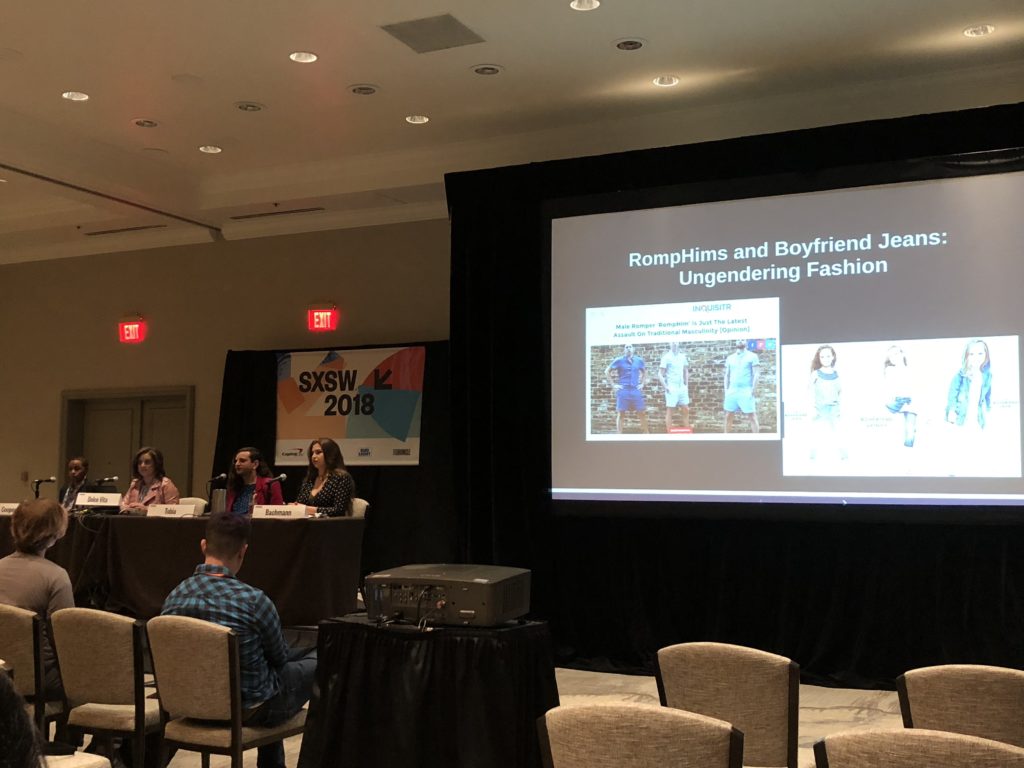They say it takes the first day to get accustomed to the hoopla that is SXSW. And while, yes, I did almost get hit by a car while creating a quote graphic, the first day went very well.
From the first panel, I knew I was in for a day of illuminating discussion, discovery and immersion in innovative topics.
It’s Time to See Through a Gender/Sex Lens
Males and females are 99 percent genetically related, but that one percent difference is the beauty of individualism, according iGiant’s Dr. Saralyn Mark.
Within that one percent difference exists a multitude of problems affecting both sexes, and Mark’s work attempts to resolve thise issues. Drugs are prescribed at similar dosages for males and females, but females often have more severe side effects. Car cabins are designed for how men sit in the driver’s seat, leaving women vulnerable to neck and head injury, not to mention chest injury from a male-oriented seatbelt. Female skiers at the Olympics are more at risk for knee and leg injury because their skis are designed for men.

More and more examples of gender and sex inequity in a variety of areas, like design, workplace and healthcare, arose from the roundtable-style panel. Attendees shared their perspectives and examples of situations where differences between the sexes caused hardship, injury or medical issues.
One man’s parents are both prescribed the same medication at the same dose, but his mother has much more adverse reactions to it than his father. A woman from Louisiana State University claimed many desks on campus are unusable by pregnant women. Another shared how her company moved weekly team meetings from evenings to lunchtime to better facilitate working mothers.
Mark herself noted that the fingerprint sensor on her phone has trouble recognizing her, stating that differences in tactile biology make it harder for a woman’s finger to be read. She said tech designed for men often neglects the unique biology of women.
Companies often brand things for men or women without doing any testing to see if those products actually uniquely benefit those specific genders. Herein lies Mark’s mission.
Moving forward, we must be conscious of, accepting of and accommodating to gender and sex differences rather than creating one-size-fits-all or gender/sex-specific-in-name-only products and environments.
My opening panel was a truly revolutionary way to kick off the conference.
Mercedes-Benz Electric Intelligence:
A small booth up on the fifth floor of the Fairmont Hotel (which barely got done in time for SXSW) housed one of my favorite experiences of the day.
Inside a darkened box lined with black-lights, rows of neon strings zigzagged across six sections of questions dealing with the future of electric cars and sustainable automotive transportation. As visitors moved through the questions, they strung their piece of string representing a specific style of car through loops attached to the walls to mark their answers.
Trends, overlapping perspectives and diverging opinions were revealed, all nearly immediately and all without relying on digital technology. I found it to be an interesting way to visualize qualitative data in a hands-on, in-person, interactive way. If I happen past it over the next few days, I’d like to follow up on the trends and what the visualization looks like.
RompHims and Boyfriend Jeans: Ungendering Fashion

I trekked to the Four Seasons for my next panel session after a stop at my favorite Houston-based food truck that’s part of the South Bites Trailer Park and a trip through Land O’ Lakes’ installation, “The Food Effect.”
This panel focused on recent trends with “gender neutral” clothing, and how even clothes that subvert gender norms or the gender binary are often branded with gendered terms. Trends over the past year, like the RompHim and Old Navy’s Boyfriend Jeans for girls were the primary examples given.
The panel, led by Anita Dolce Vita of DapperQ, featured prominent voices in the queer and gender nonconforming communities: Chaka Bachmann of The Defiant Femme, Danielle Cooper from She’s a Gent, and LGBTQ rights activist and feminist writer Jacob Tobia.
Discussion revolved around how the queer community is at the forefront of ungendering fashion. Recently, agender and ungendered fashion has been portrayed as a passing trend by the mainstream media, and even gender neutral style is masculinized. Dolce Vita referenced a recent spread in Vogue Magazine featuring Gigi Hadid and Zayn Malik in gender nonconforming outfits. Hadid was dressed in traditionally masculine suits, while Malik was dressed in…traditionally masculine suits…with florals.
Tobia especially aired their complaint that Vogue dressed Malik in what’s considered standard mens wear while attempting to break the gender code.
Moving forward, the panel agreed that ending the perpetuation on gendered stereotypes at an early age is key to creating an ungendered society. Tobia said what the panel discussed wasn’t novel, but that it expressed struggles and characteristics of identities that have existed throughout human history.
“There’s nothing new happening on stage here. It’s a resurfacing of things that have been pushed down forever.” — Jacob Tobia
Looking forward to Saturday
Day two will be even better, I’m sure.
I’ve favorited several panels on design and coding, one on the LGBTQ community following the Pulse Nightclub terrorist attack, and I hope to check out some cool installations and “houses” around Austin. I missed the puppies at Mashable House Friday, so hopefully they’re back Saturday!

